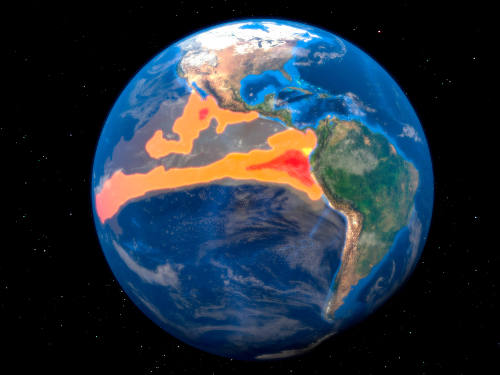The state of smart cities in MENA
11 December 2025
Published online 18 January 2018
A climate model that simulates El Niño can help predict droughts in the Arabian Peninsula.

© Science Photo Library / Alamy Stock Photo
Global climate is affected by changing weather patterns in the Pacific Ocean. Normally, trade winds moving from the eastern Pacific push warm surface waters westwards. Some years, however, these trade winds weaken, causing the warm surface waters to spread eastwards toward the coasts of Central and South America.
This phenomenon, known as El Niño, affects the climate by shifting cloud and rainfall eastwards. Eventually, the Pacific trade winds pick up again, sometimes becoming stronger than normal, pushing warm water and its connected weather system toward Asia. This phase of ENSO is called La Niña.
“ENSO tends to control the seasonal rainfall variability and predictability in many regions around the globe,” says KAU climatologist Muhammad Abid. “However, the Arabian Peninsula is not much explored in the climate community.”
Abid and colleagues at KAU’s Center of Excellence for Climate Change Research on Saudi Arabia’s west coast in Jeddah compared observational data and climate simulations of summer rainfall over the Arabian Peninsula for the period from 1981 to 2015.
They found that El Niño affected 71% of drought years in the southern and southwestern parts of the Arabian Peninsula, while La Niña was linked to 38% of this area’s flood years.
Also, KAU’s Atmospheric Global Climate Model, adapted from a model developed by Seoul National University, was able to reasonably predict rainfall in the region. The model, which simulates ENSO weather patterns, had 65% higher predictability for the region’s rainfall during El Niño years compared to La Niña years, meaning that it is better at predicting dry conditions in the region than wetter ones. This may help in the management of regional water resources so that local agriculture is not markedly affected during droughts, Abid explains. But models are mathematical tools, says Abid, whose predictions can never be fully accurate. This could give rise to false alarms, he says. The KAU team hopes to improve their model and to explore what other factors affect rainfall in the Arabian Peninsula.
Climate and earth modeling experts Georgiy Stenchikov and Ibrahim Hoteit from Saudi Arabia’s King Abdullah University of Science and Technology, who were not involved in the study, say the results demonstrate that KAU’s Atmospheric Global Climate Model shows potential for predicting rainfall in the region.
Although it is not surprising that ENSO affects precipitation over the Arabian Peninsula, its apparently strong effect is, says Stenchikov. This could partly be due to the study’s focus on a specific area that is responsive to ENSO. The model could also be exaggerating this link, he says.
Hoteit adds that additional information on the study’s experimental setup would have been useful, such as demonstrating that the model can reproduce realistic ENSO events.
The model’s relatively low resolution also means it will probably be able to resolve large-scale phenomena, such as the large belt of low pressure that extends from Africa to the Indian monsoon region and appears in the southwestern Arabian Peninsula; but will not be able to resolve some regional phenomena that may also contribute to summer rainfall in the region, such as the Tokar Jet: strong summer winds that blow from Africa through a gap in the mountain range lining the west coast of the Red Sea, Hoteit says.
doi:10.1038/nmiddleeast.2018.5
Stay connected: